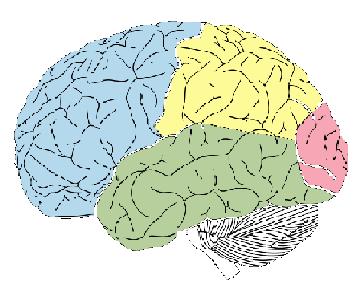The study found that the right parietal lobe is responsible for dyscalculia. The finding may have far-reaching consequences for the diagnosis and treatment of dyscalculia with corrective instruction
For the first time in history, scientists have succeeded in causing mathematical difficulties (dyscalculia) in people who normally do not suffer from such. The study found that the right parietal lobe is responsible for dyscalculia. The finding may have far-reaching implications for the diagnosis and treatment of dyscalculia with corrective instruction.
In blue: the frontal lobe, in yellow: the parietal lobe, in green: the temporal (temporal) lobe, in pink: the occipital lobe, in white: the cerebellum and the brainstem.
Dyscalculia is at least as common as dyslexia and ADHD, close to 5% of the population has it. Despite these facts, dyscalculia has not received the attention that other disorders have, perhaps, in part, because the brain dysfunction that causes dyscalculia remains a mystery. Therefore, many hopes depend on research and the possibility that it will lead to better diagnosis and treatment of the disorder.
Dr. Roy Cohen-Kadosh, from the UCL Institute of Cognitive Neurology says: "This is the first causal demonstration of the fact that the parietal lobe is the key to understanding the development of dyscalculia. Most people process numbers easily - almost automatically - but not people with dyscalculia. We wanted to test what would happen when the areas relevant to learning mathematics, in the right parietal lobe, were completely shut down for a few hundred milliseconds. We found that stimulation of this area of the brain during a math test radically affects the reaction time of the subject [the research subject - is the person on whom the experiment was done at that moment].
"This provides strong evidence that dyscalculia is caused by a deformation of the right parietal lobe, and provides solid ground for further research into the physical abnormalities in dyscalculic brains. This is an important step towards the ultimate goal of early diagnosis with the help of neural tissue analysis, which will lead to earlier and more effective treatment through corrective teaching."
By using TMS (neuronavigated transcranial magnetic stimulation) to stimulate the brain, the scientists were able to induce, for a short time, dyscalculia in subjects who did not suffer from dyscalculia, while they completed mathematical tasks that required comparing two numbers, one physically larger than the other, while the other numerically larger than the first. For example, subjects were asked to decide which number was numerically larger, 2 or 4, when the 2 was presented in a larger font.
The effect of the TMS on the subject lasted only a few hundred milliseconds, and was carried out exactly at the time when the subject had to evaluate the numbers and decide whose value was higher, or who was physically bigger. The test was designed to measure the automatic processing of numbers in the subject, and tested both people who suffer from the dysfunction and those who do not.
The researchers found that participants without dyscalculia exhibited dyscalculic behavior in number processing only when the TMS induced neural disturbances in the right intraparietal fissure (IPS). The findings were also verified through the examination of subjects suffering from developmental dyscalculia. The dyscalculic group reached a replication of the behavioral results of the non-dyscalculic group during the TMS perturbations to the right parietal lobe, but not after similar perturbations to the left parietal lobe or after sham stimulation.
This innovative approach, of a direct comparison between healthy subjects, with simulated dyscalculia following the effect of TMS, and subjects suffering from developmental dyscalculia, allowed the researchers to propose a direct causal relationship between deformations along the right IPS, and between developmental dyscalculia.
The brain is one of the most mysterious organs in the human body. Are we on the brink of a new era, in which diseases and brain disorders will be solved with the help of drugs or corrective instruction, of one kind or another? But perhaps the sword of Damocles is swinging over our heads. Knowledge is power, but it is also objective. How humanity and the political bodies at its head will choose to exploit it, is the question facing the entire scientific community.

